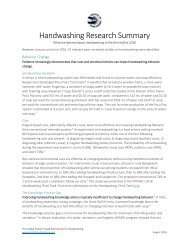WASH’ Nutrition
manuel_wash_nutrition_online
manuel_wash_nutrition_online
Create successful ePaper yourself
Turn your PDF publications into a flip-book with our unique Google optimized e-Paper software.
If the budget available for WASH activities is low, the recommendations are to:<br />
Prioritize provision of a WASH minimum package for the affected households (see Pillar 5 of the <strong>WASH’</strong><strong>Nutrition</strong><br />
strategy) and awareness-raising sessions for mothers/caretakers of children admitted to SAM treatment programme.<br />
Include interventions to ensure sustainable access to safe water, adequate sanitation and hygiene items and products<br />
in the health facilities (see Pillar 5 of the <strong>WASH’</strong><strong>Nutrition</strong> strategy and Chapter 4 for example activities in the health<br />
and nutrition centres). Priority has to be given to the health structures which have the largest admission of SAM cases<br />
and those receiving inpatients.<br />
If the budget available for WASH interventions is higher, in addition to what is recommended above:<br />
Include WASH activities in the most affected communities, or in the case of a prevention approach, in the communities<br />
most vulnerable to undernutrition (see Chapter 4 for example activities at the community level).<br />
Include interventions aiming at strengthening construction/rehabilitation work in health care facilities and expending<br />
the coverage of supported health structures.<br />
Include barrier analysis to ensure greater impact of hygiene promotion and behaviour change activities (see Pillar 3 of<br />
the <strong>WASH’</strong><strong>Nutrition</strong> strategy).<br />
It is worth noting that local, inexpensive, more sustainable solutions<br />
such as soap and chlorine production and social marketing should be<br />
preferred over distribution of the same items. Similarly, investments<br />
in hard, sustainable WASH infrastructure should be prioritized as<br />
replacements of poorer quality infrastructural parts often cost more<br />
than one more sustainable building.<br />
In recent years, the number of donors who incorporate multi-sectoral<br />
components into their funding strategies has increased. Without<br />
claiming to be exhaustive, the Programmatic resources section<br />
provides a brief overview of several funding agencies which encourage<br />
the integration of WASH and nutrition actions. Also, an example of<br />
budget elements for an integrated WASH and nutrition project 91 can<br />
be found in the Programmatic resources section.<br />
In the Democratic Republic of Congo, adding the<br />
smallest WASH component to an ACF emergency<br />
nutrition project managed to claim about<br />
16% of the budget for the most basic package<br />
(WASH kits for the children admitted to SAM<br />
programme, provision of temporary solutions for<br />
water treatment and storage at health centres, a<br />
few rehabilitations of infrastructure, for latrines<br />
especially. In Nigeria, a similar approach managed<br />
to obtain 40%. Therefore, cost calculations and<br />
budgeting are always context specific.<br />
NOTE<br />
2.4. Common barriers, challenges and needs for successful integration<br />
While the impact of WASH on nutrition and vice versa is acknowledged, numerous difficulties in implementing integrated<br />
programmes for improved health outcomes still remain. In other words, unless WASH or nutrition indicators are included in<br />
project objectives, there is little incentive to work towards an integrated goal. 92 WASH and nutrition programme managers can<br />
use the information from Table 5 for project planning, to prepare for challenges they might encounter and better understand<br />
what conditions are necessary for successfully integrated programmes. 93<br />
91 - Example taken from the ACF mission in Nigeria, 2014/15<br />
92 - Teague et al (2014) “Water, sanitation, hygiene, and nutrition: successes, challenges, and implications for integration”<br />
93 - Based on the study conducted by Teague et al (2014) in 6 countries and 10 organizations<br />
52<br />
<strong>WASH’</strong><strong>Nutrition</strong><br />
A practical guidebook



